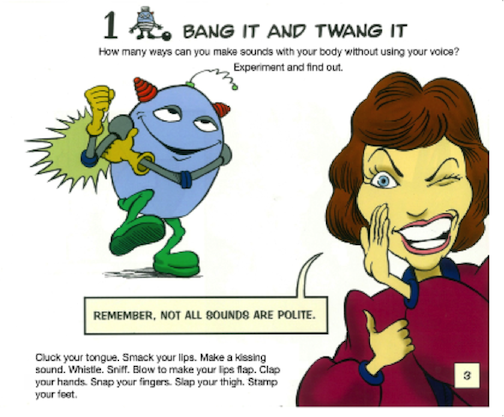How do we create scientists? How do we get people to think as scientists think? What is the underlying process that distinguishes a scientist from thinkers in other disciplines? Can children learn to think like a scientist by reading a book? The Common Core State Standards believe that yes, habits of thought can be acquired through the reading and writing of nonfiction. I agree, but a lot depends on the accessibility of the book and how it’s read. Since many of my books address those first three questions directly, perhaps it might be useful for me to give some specifics about how teachers can use my concept-driven hands-on science books to meet the CCSS. As an example I’ll use one book from my “Science Fun” series, “Bangs and Twangs,” which can be used to teach a middle school unit on sound.
First, this book is not designed to be read in one sitting the way one might read a story. I intend that the reader periodically stop reading and think. There’s no mystery about when this is to happen. Throughout the text I ask questions. These are not rhetorical questions, which are often used to drive a narrative. They are the same kind of inquiries that drive a scientist. So one obvious strategy for a teacher in a shared classroom reading activity is to interrupt the reading and discuss the question. Also, since my first objective is to connect the reader personally to the subject of the book, I sometimes combine a question with a universal personal experience. This is the opening page of “Bangs and Twangs”:

A teacher using this book could stop right after reading the opening page and get students involved in activities and discussions. Instead of talking about “observation” as the initial phase of the “scientific method,” I make suggestions that have students actually observe. Challenging them to come up with a panoply of ways to create sounds without using their voices, instantly engages them with the subject and prepares them to learn more. It also fosters creative and divergent thinking.
I then expand the concept by having the reader go around the house (or schoolroom) looking for ways to make different noises. So the teacher could read this next section and continue to have the students experiment and discuss their findings. Then they could write and document their findings and the next day they could continue reading the book and experimenting, and practice their literacy skills.
In the text that follows the opening, I want my reader to observe more closely. Science is about finding clever ways to see things that are not obvious to the casual observer. In “Bangs and Twangs,” the next step is to see what actually generates a sound. So I have the reader hang a rubber band on a doorknob, pull it taut, and pluck it so that it twangs. I tell students to look at the rubber band; even using a magnifying glass, so they see how the rubber band is vibrating as sound comes out. I ask them to pull it tighter and see how the pitch changes.
To nail down the concept of how sound is produced, I connect this new knowledge about vibration and pitch to something else they already know something about — musical instruments, the harp, the piano and the guitar. This sequence:
1. Connect a child to familiar observation
2. Investigate it in an inventive way to reveal new knowledge
3. Apply the knowledge to other familiar applications
—is a pattern I repeat over and over again in subsequent chapters in the book. I am careful to introduce new information — for example, how the ear is constructed to hear sound — only when it is needed to continue the exploration of the physical nature of sound. In introducing new concepts in science, I never stray very far from what children already know. In this way, I build a conceptual armature not only for a specific subject but for the way scientists think, create, strategize and interpret their findings.
Often the hands-on activities in my books are very simple and have little significance outside of the context of the book. Yet, the doing of these activities as related to concepts can lead to further activity on the part of the reader. Science is not about passive reading — it’s all about active involvement. In other words, following this book models the behavior of scientists.
Bangs and Twangs is now available for the iPad.


Leave a comment